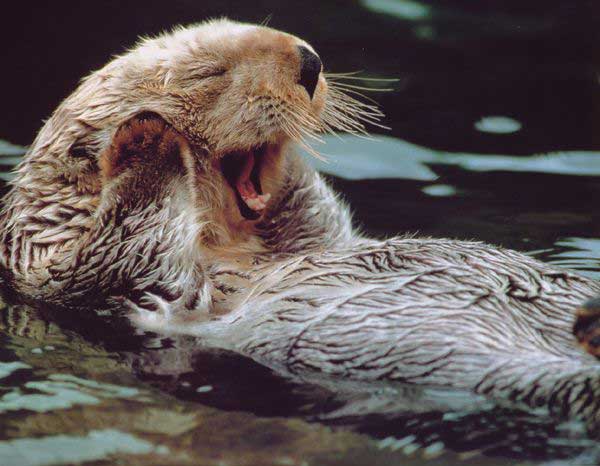Hello everyone,
There is a wetlands marsh relatively near my house that I've been to since I was little. I mention this because I went there a few weekends ago with my dad and as we were walking along, looking at the frogs, tadpoles, snapping turtles and birds, I realized something. For the amount I love all those creatures, I don't know that much about them. I possibly did at one time, but other than the basics and the inferred guesses I make, my knowledge is limited. So, I'm going to change that. Though it's none of the animals I mentioned previously, otters (specifically Sea otters) are the focus of today's conversation.
Doesn't that make you smile? He's just so happy (or he's yawning...)
Sea otters are keystone species--which are species that have great influence in an ecosystem though they aren't necessarily high in number (or, put differently, they only make up a small percentage of the total animal population.) What does this mean? They are important, really important. Why they are important relates to how impressibly interconnected ecosystem are, and things called "feedback loops". So, otters eat sea urchin (among other things). Sea urchins eat kelp. So, if there are enough otters (or too many) sea urchin numbers will be maintained and all is, relatively, good. However, if there aren't enough otters, this leads to an increase in sea urchin populations. More sea urchins means they are eating more kelp. What's bad with that? Kelp (and kelp forests) are extremely productive, provide a home for many creatures (including the fish we eat, crabs, otters themselves and more) and ecosystem services (like filtration of water). Less kelp has large, negative impacts on entire ecosystems. In short, we should love otters because they are cute but also because they, along with others, keeps entire ecosystems in balance.
Fun fact, otters often wrap themselves up in kelp when they are resting so they don't drift away. In addition, they do 'hold hands' or rather 'hold paws'.
awwwwwww(:
Status: Threatened
Sea otters inhabit the coasts of the Pacific Ocean
They eat meat (sea urchins, clams, mussels, fish, and many other different types of animals)
In order to crack open the shells, they place a rock on their stomachs and smash the shells against it until the shells break/open. (Pretty ingenious if you ask me).
Also, I believe that they eat about 30% of their body weight each day to meet their caloric needs because their metabolism is so fast.
They average 65 pounds, but some can get up to 90, and are around 3 to 4 feet long.
They can walk on land but mostly they stay in the water
In the early 1900s, otters populations were decimated for their fur. Their numbers went down to around 1000. However, now that their are protected under law and their numbers have greatly increased.
Oil spills and human habitat destruction (by direct contact and by pollution, over harvesting of fish and other animal species, and kelp forest destruction) are threatening these species. In addition, getting caught in fishing lines or just simply killed (on purpose) by fisherman also threatened them. Fisherman kill otters (though it is illegal) because otters eat fish sometimes, and thus the fisherman believe that if you get rid of the otters, then there will be plenty of fish. However, the reality of it is that if you got rid of the otters, there would be no kelp and thus less habitat for fish to live and to breed (leading to less fish). Another killer of Sea otters are parasites. And, big surprise here, humans are causing this. Tons of waste gets washed into the pacific ocean. In this waste is cat litter (because some people flush their cat litter down the toilet... I'm being serious though, it happens) and in this cat litter is Toxoplasma gondii. And lastly (though there is more, I just don't want to think abut dying otters anymore) fertilizers (which contain products that cause toxic algal blooms.
Unfortunately, while numbers are not down to where they were in the early 1900s, the future doesn't look to great for this species. (I think the saddest thing is that, the latter part of that statement holds true for most of the animals in the world).
But as always, there are things to do. Other than just being more environmentally friendly in your lifestyle, you can:
- Tell people about the problem. (and I'm sure some people think that is silly, but it's the basic step to address the problem. If no one knows about the problem, no one is going to care. And if no one cares, no legislation, no government action will be taken to solve it.
- If you live on the coast of the Pacific Ocean (such as Monterey Bay), see if local initiatives are in place. Hands on work to help the otters (such as cleaning up the beaches) is always great.
- Adopt a sea otter. Yeah it costs about 20 dollars, but, in my personal opinion, it's awesome. I am thinking about adopting some creature (this is a whole list of animals you can 'adopt'. Here's a link: http://www.defenders.org/sea-otter/how-you-can-help
- Don't ever (and this should probably be number one) by real fur (whether it be for hats, coats etc). If you really want a fur hat, buy a fake one
For more basic facts I've found that the national geographic animals' pages are awesome.
I hope you enjoyed this nature chat.
Stay tuned for more,K


No comments:
Post a Comment